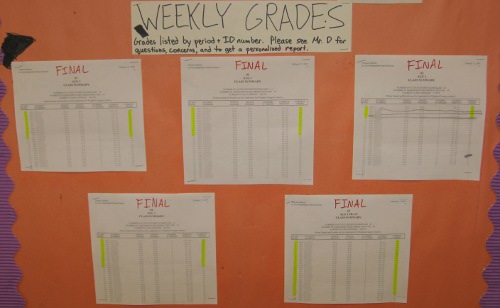The cover story of this month's issue of Wired magazine is about how the brain works in and how we can change our behavior. The main process is through feedback loops: we collect and receive relevant real-time data, we're shown clear consequences (positive and negative) to what we do with the information, and then we do it.
They use the example of a small town in California that had tried everything to get people to slow down in a busy school zone. Nothing works until they created a sign that electronically showed each person's speed (as measured by a built-in radar gun) and then below it says the actual speed limit. It made a huge dent in getting people to slow down, and now "Your Speed" signs are all over the country.
As I read this I thought about the feedback loops I've been creating in my classroom over the years. Clearly there's plenty of applications for this as we get better with data, but I was thinking of the more practical, day-to-day uses of this concept.
I used to post students grades on a weekly basis on a bulletin board (using student IDs instead of names, as seen above), but this was an incomplete loop. The data was relevant and there, but there was no consequence or clear paths of action to take. I just kind of hoped students would get the idea. Not surprisingly, it did little to inspire students to get or stay on track.
Far more effective was the detailed list of assignments, grades and category percentages that I would give every student at the midpoint and end of each grading period (usually a six week period). Students had relevant real-time data, and because I kept file folders containing copies of assignments (with labels/dates consistent with what was on their report) they could easily take action. Usually I gave them part or all of the period to do this, and this would have a huge effect on getting students to make up work and pull up their grades.
This is an effective loop, but would be better if I gave out these detailed reports weekly or biweekly and skipped the posted grades. It would likely eliminate the need to set aside "make up" time at all.
I feel like this research has almost limitless applications in our complex profession. What successful and unsuccessful feedback loops have you created in your classroom? What potential do you see in this cycle to make positive changes in your students going forward? Check out the article and share your thoughts in the comments.
